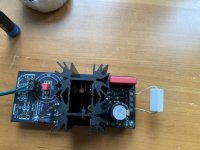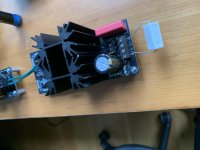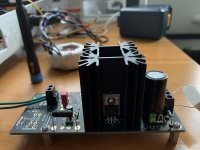I have a few reflektor ds and reflektor minis. I'd like to use some combination to power the below. For the DAC, I may keep the l adapter given the higher current demands or try to sink a reflektor mini appropriately.
- Main DAC supply (550ma if powering AVCC separately)
- L/R AVCC analog supply for DAC (currently powered through main DAC supply and then an on board regulator) (100ma per side)
- Separate i2s reclocker (2-300ma to be safe)
In theory, would the highest quality be using a 4 pole cap on a dc flexy board to feed the minis and reflektors? I am thinking of using one or two flexys to power the L/R AVCC. I have a 10k 4 pole mundorf I could use to feed both, or get another to keep channels completely separate. 10k is probably overkill here, would a 6800uf offer any advantages with lower current loads?
The reclocker is easily powered by a reflektor d and the DAC could be powered by a properly cooled reflektor mini. Would using 4pole caps on separate DC flexys be overkill to feed all of these supplies?
It seems some like the reflektor D with high quality resistor for analog and the JFETS for digital. I could also power one or two reflektor Ds with an off board dc flexy and 4 pole to power the AVCC L/R channels and use the reflektor minis with JFETS to power the DAC and reclocker. Again, maybe overkill.
- Main DAC supply (550ma if powering AVCC separately)
- L/R AVCC analog supply for DAC (currently powered through main DAC supply and then an on board regulator) (100ma per side)
- Separate i2s reclocker (2-300ma to be safe)
In theory, would the highest quality be using a 4 pole cap on a dc flexy board to feed the minis and reflektors? I am thinking of using one or two flexys to power the L/R AVCC. I have a 10k 4 pole mundorf I could use to feed both, or get another to keep channels completely separate. 10k is probably overkill here, would a 6800uf offer any advantages with lower current loads?
The reclocker is easily powered by a reflektor d and the DAC could be powered by a properly cooled reflektor mini. Would using 4pole caps on separate DC flexys be overkill to feed all of these supplies?
It seems some like the reflektor D with high quality resistor for analog and the JFETS for digital. I could also power one or two reflektor Ds with an off board dc flexy and 4 pole to power the AVCC L/R channels and use the reflektor minis with JFETS to power the DAC and reclocker. Again, maybe overkill.
Its not easy to determine an optimum strategy before comparing those options in the application itself. In theory you could first bet on powering the more critical components regs from your best rectification available.
Given that the produced ripple on the reservoir output isn't eating away too much DC margin. Keeping the minimum 5V Raw DC in - Vout recommended distance for those regs. Depends on loading, capacitor value, and transformer output level.
Given that the produced ripple on the reservoir output isn't eating away too much DC margin. Keeping the minimum 5V Raw DC in - Vout recommended distance for those regs. Depends on loading, capacitor value, and transformer output level.
Salas, I'm not sure what you mean on the below point.
"Given that the produced ripple on the reservoir output isn't eating away too much DC margin. Keeping the minimum 5V Raw DC in - Vout recommended distance for those regs. Depends on loading, capacitor value, and transformer output level."
I plan to use a 10K uf 4 pole Mundorf Mlytic+ on a dc flexy to try feeding a reflektor d to start. I will use a 30VA transformer with dual 9v secondaries, likely feeding another flexy board or reflektor d regulator.
Are 9v secondaries acceptable for 5v out and 3.3v out?
Also, is it possible to use one reflektor D to power two separate loads if not using 4 wire kelvin wiring or would I need to use two reflektors?
"Given that the produced ripple on the reservoir output isn't eating away too much DC margin. Keeping the minimum 5V Raw DC in - Vout recommended distance for those regs. Depends on loading, capacitor value, and transformer output level."
I plan to use a 10K uf 4 pole Mundorf Mlytic+ on a dc flexy to try feeding a reflektor d to start. I will use a 30VA transformer with dual 9v secondaries, likely feeding another flexy board or reflektor d regulator.
Are 9v secondaries acceptable for 5v out and 3.3v out?
Also, is it possible to use one reflektor D to power two separate loads if not using 4 wire kelvin wiring or would I need to use two reflektors?
Last edited:
In the L-Adapter pdf manual there's a link to a post I made on how to predict AC ripple voltage on a main filtering capacitor for max load current consumption, capacitance, and transformer secondary voltage.
When planning to support several CCSed regulators from a common raw DC source, just add up their CCS settings for max and plug the number in that ripple equation.
See that at least 5VDC more than Vout remains after AC ripple is deducted from a zero load raw DC level calculation.
Your transformer and main capacitor don't seem small but knowing how much you can load the raw DC source with various DCin regs at various CCS settings is good info to plan your experiments limit. In this case knowledge is literally (max) power.
For best results better use individual regs for individual loads although the opposite is doable and economic as with any other psu type. Depends on the specific loads PSRR as much. Their sensitivity to rail modulation or not in other words.
When planning to support several CCSed regulators from a common raw DC source, just add up their CCS settings for max and plug the number in that ripple equation.
See that at least 5VDC more than Vout remains after AC ripple is deducted from a zero load raw DC level calculation.
Your transformer and main capacitor don't seem small but knowing how much you can load the raw DC source with various DCin regs at various CCS settings is good info to plan your experiments limit. In this case knowledge is literally (max) power.
For best results better use individual regs for individual loads although the opposite is doable and economic as with any other psu type. Depends on the specific loads PSRR as much. Their sensitivity to rail modulation or not in other words.
Thanks. If using off-board DC rectification with the Reflektor D, is the below cap okay for for CD?
MKP2F031001F00JSSD WIMA | Mouser
MKP2F031001F00JSSD WIMA | Mouser
By the way, regarding raw DC dynamics prediction, you could also simulate with Duncan's PSU software. There is CCS load option instead of resistor there too so you can directly enter the load current. Because in CCSed shunts that's the load to the raw DC section. Known & steady at all times.
PSUD 2.10 released
PSUD 2.10 released
Hi Salas,
I am bulding Reflektor-D to power the USB to I2S module by diyinhk.
It requires 3.3V 200mA power source. According to the instructions I should be using 1.2-1.5R for current setting resistor, but I only have 2 watt 1 ohm, 2.2 ohms and 3.9 ohms at hand. So I could either use 1 ohm or 2.2/3.9 in parallel to get ~1.4 ohms. What do you think is the best value to use here?
Also I am bit worried about RR value since I haven't measured IDSS of J1 since it's SMD and super small. I am using 2SK880GRTE85LF. Should I go for 100R?
BTW, my transformer has 9V output (0.8A).
I am bulding Reflektor-D to power the USB to I2S module by diyinhk.
It requires 3.3V 200mA power source. According to the instructions I should be using 1.2-1.5R for current setting resistor, but I only have 2 watt 1 ohm, 2.2 ohms and 3.9 ohms at hand. So I could either use 1 ohm or 2.2/3.9 in parallel to get ~1.4 ohms. What do you think is the best value to use here?
Also I am bit worried about RR value since I haven't measured IDSS of J1 since it's SMD and super small. I am using 2SK880GRTE85LF. Should I go for 100R?
BTW, my transformer has 9V output (0.8A).
Surely use the 1.4Ω paralleled option. That will keep the reg's dissipation in check and won't push your transformer. Remember, current rating of transformers is AC and translates differently with rectification style. Full bridge rectifier clips that spec by 40%.
RR value is nice to home in but not a crucial aspect, especially when not using two regulators in symmetric applications, where you could want them equal in all areas.
Go for 100R and you can discover the Id mA result in circuit by mV across RR divided by 100. If too weak or too strong, SMDs are very easy to push away with the iron and try another.
RR value is nice to home in but not a crucial aspect, especially when not using two regulators in symmetric applications, where you could want them equal in all areas.
Go for 100R and you can discover the Id mA result in circuit by mV across RR divided by 100. If too weak or too strong, SMDs are very easy to push away with the iron and try another.
Go for 100R and you can discover the Id mA result in circuit by mV across RR divided by 100. If too weak or too strong, SMDs are very easy to push away with the iron and try another.
OK, got some measurements today. Output is steady ~3.33 VDC which is fine. Voltage across RR was 170mV that seems to be bit low for 100R I used. I have one more 2SK880GR to try with or there's anything else I could do? Gonna be hard to re-soldier that tiny jfet with all the parts on the board already.
Thanks. 170mV/100R=1.7mA which is fine when the rough in circuit Idrain target is 2mA by design. The 2N transistor in the main CCS is still well biased with that much. No need to replace anything.
Glad to hear. Thanks again
Salas, I've tried powering up the reflektor for the first time but the LED is not lighting up. I'm using a dc flexy and am measuring dc out from that board. I believe the parts are all correct. Do you see any issues in the photos?
Attachments
Salas, I had been using the following to power my dac: (1) L adapter to Buffalo9038Pro DAC; (2) Reflektor d full version powering AVCC; (3) reflektor mini powering cronus reclocker; and (4) ultrabibs powering mercury i/v stage. All reflektors are powered by separate dc flexy boards.
I recently finished another reflektor mini to power the DAC. When I swap it with the l adapter it works and the DAC sound fine, but I get an audible high pitch whine coming from the DAC when I put my ear by it. This isn't noise in the signal line, it's an audible external noise. When I touch the heatsink of the reflektor mini the sound changes pitch slightly. When I remove the reflektor powering the cronus (which is connected via i2s lines and clock line to the DAC) the sound goes away, even when powering the DAC with the same reflektor.
Do you have any ideas? The l adapter was fine. I've tried different transformer combos as well, but when everything is hooked up I get the DAC noise. I've tried using separate transformers for everything, but the problem persists.
I recently finished another reflektor mini to power the DAC. When I swap it with the l adapter it works and the DAC sound fine, but I get an audible high pitch whine coming from the DAC when I put my ear by it. This isn't noise in the signal line, it's an audible external noise. When I touch the heatsink of the reflektor mini the sound changes pitch slightly. When I remove the reflektor powering the cronus (which is connected via i2s lines and clock line to the DAC) the sound goes away, even when powering the DAC with the same reflektor.
Do you have any ideas? The l adapter was fine. I've tried different transformer combos as well, but when everything is hooked up I get the DAC noise. I've tried using separate transformers for everything, but the problem persists.
MOSFETs look to be isolated. I also tried it without a heatsink to be sure there was no connectivity and still got the sound. When I use the full-sized reflektor with dc flexy connected to the DAC, one reflektor mini connected to cronus and one for AVCC the noise is NOT present. The DAC is getting sufficient current with any of the boards. When I swap either reflektor mini in to feed the DAC, the noise returns.
There is no audible impact on the music signal. I've attached a recording of sound - the DAC is off first, I switch it on and then touch the heatsink a few times which modulates the noise. It sounds like a high-frequency noise, similar to when a radio is searching for channels.
There is no audible impact on the music signal. I've attached a recording of sound - the DAC is off first, I switch it on and then touch the heatsink a few times which modulates the noise. It sounds like a high-frequency noise, similar to when a radio is searching for channels.
Attachments
- Home
- Amplifiers
- Power Supplies
- Reflektor-D builds


